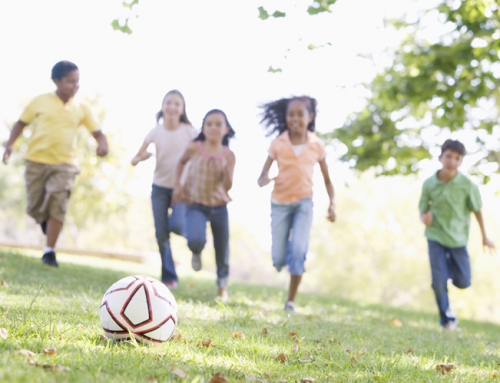Without a doubt this is the one question, reservation and objection that is raised most often. It is usually the one raised first. It is often the one most hotly debated. And common experience among homeschoolers is that socialisation, rather than academic achievement, is the issue over which friends, relatives and educational authorities show the most concern.
What Is Socialisation?
Popular opinion assumes that children need long periods of interaction with a large group of age-segregated peers to acquire social skills. Now assuming that most of the time spent in the classroom is not spent in interacting but in paying attention to the teacher and doing the assigned work, where does most of the interaction take place? During lunch and break times, and before and after school. And who is supervising this interaction on the playground, on the school bus and on the streets to ensure that the right kind of socialisation is taking place? It is not the teachers but the children themselves. In the typical public school setting, children are being left to socialise themselves as best they can.
This fits in with today’s prevailing philosophy, which holds that children are inherently good or perhaps neutral, like blank cassette tapes, and that left to themselves, they will inevitably develop and adapt toward the highest good attainable by the group as a whole. (Although it is unpopular to say so, when this is translated into practical reality it means conformity to the lowest common denominator.) This inevitable “upward” development and adaptation is an idea developed from the theories of evolution.
Unfortunately it was developed in the absence of a) other tenets of evolutionary thought, b) common experience and c) traditional Christian/Western wisdom, all of which contradict this foundational premise upon which our modern ideas of child socialisation are based.
Let us examine these three contradictions to the prevailing thoughts on socialisation:
- Another tenet of evolution is the survival of the fittest. This is the law of the jungle, eat or be eaten, brute force prevails, might makes right. This is the tendency of children’s behaviour on the playground unless there are sufficient adults present to prevent it.
Even though children are infinitely varied, the socialisation at school causes them to conform to the codes dictated by their particular class or group. We have all witnessed the same phenomenon: There are the few at the top who are setting the pace and the codes, there are the vast numbers in the middle who quietly conform and try to keep out of harm’s way, and there are those at the bottom of the pecking order who are ostracised, victimised, bullied, teased, etc., because they do not conform in their dress, their size, their looks, their speech, their behaviour or whatever.
- Common experience tells us this profound truth: Monkey see, monkey do. Children emulate the behaviour of those around them. If they spend most time around their friends, they copy them. If it is with the Ninja Turtles on TV, they will copy them. If they spend most time around their parents, they will emulate them.
Most parents know only too well the immediate results of this “copy cat” form of socialisation. After lengthy play with their friends, children can be “hyper” and disrespectful and try out the unacceptable speech or actions they have just picked up from their peers. How true is the ancient proverb, which says, “He who walks with wise men becomes wise, but the companion of fools will suffer harm.” (1)
- Christian wisdom says that children are not basically good or neutral but are fallen, that is, they possess an inherent tendency toward foolishness which manifests itself in temper tantrums, disobedience, disrespect, dishonesty, destructiveness, etc. Proverbs 22:15 says, “Foolishness is bound up in the heart of a child, but the rod of correction will drive it far from him.” In other words, children do not need other children to teach them how to be children. Instead they need loving, responsive adults committed to teaching them, training them, giving them the discipline and setting them the right example in the social graces.
Children do not of themselves learn the social arts of respect, honesty, patience, gentleness, kindness, faithfulness, manners, or self control; they must have conscientious adults to model, discipline, teach and train them to internalise these behaviour traits as habits.
Origins of Modern Socialisation Theories
Critics of homeschooling claim that such children will not be the same as their conventionally schooled friends and will not fit into the peer group. The origins of this concern are somewhat sinister.
First there was Horace Mann, an early leader in the public school movement. He favoured the Prussian patterns of state education because, as he put it, it was devised “more for the purpose of modifying the sentiments and opinions of the rising generation according to a certain government standard than as a mere means of diffusing elementary knowledge.”
Then there was John Dewey, the father of progressive education. He saw truth not in absolutes, but in terms of universal ideas developed and agreed to by a group. A “thesis” or proposed truism would emerge from the group. It would at some stage meet with an opposing idea, an “antithesis.” Debate and conflict would ensue until a compromise or “synthesis” was reached. This synthesis then became the thesis and the whole process would be repeated. For those who don’t recognize it, this is classic Marxist dogma.
Truth to Dewey was derived by a distillation process within the ‘group’. To educators like him, the interaction of children with others in order to help distill these universal ideas of truth is education.
Both Horace Mann and John Dewey believed that this type of education needed to be led by an elite, those educators who had been instrumental in the formation of public education policy, who could gently lead others through this “distillation” process. To have children who did not or would not fit in with the group would be to hamper the distillation of truth, as directed by this elite.
We find, then, that this concern over homeschooled children not being socialised is actually a political concern that they will not be as easily manipulated by the elite as those who do fit into this all-important group.(2)
Group Socialisation
The following comments are by Dr. James C. Dobson who is Associate Clinical Professor of Pediatrics, University of Southern California School of Medicine; President of Focus on the Family Magazine and Focus on the Family radio programmes which are heard daily on 1400 radio facilities around the world; and author of best-seller, Dare to Discipline.
I have been increasingly concerned during the past 10 years about the damage done to our children by one another. The epidemic of inferiority and inadequacy seen during the teen years is rooted in the ridicule, rejection, and social competition experienced by vulnerable young children. They are simply not ready to handle the threats to the self-concept that are common in any elementary school setting.
I have seen kids dismantle one another, while parents and teachers passively stood by and observed the “socialisation” process. I’ve then watched the recipients of this pressure begin to develop defense mechanisms and coping strategies that should never be necessary in a young child.
Dozens of investigations have demonstrated, (at least to my satisfaction), the error of the notion that children must be exposed to other children in ‘order to be properly socialised’. I just don’t believe it. In fact, the opposite is true. They need the security and love of parental protection and guidance until their self-concepts are more stabilized and established.
In summary, I believe the home school is the wave of the future. In addition, it provides a third alternative to a humanistic public school and an expensive or non-existent Christian school.(3)
Socialisation and the Occurrence of Genius
In 1960 Harold G. McCurdy examined “The childhood pattern of genius” in a study supported by the Smithsonian Institution of Washington, D.C. In summary, McCurdy wrote:
The typical developmental pattern includes as important aspects:
- a high degree of attention focused upon the child by parents and other adults, expressed in intensive educational measures and, usually, abundant love;
- isolation from other children, especially outside the family; and
- a rich efflorescence of fantasy as a reaction to the preceding conditions.
It might be remarked that the mass education of our public school system is, in its way, a vast experiment on the effect of reducing all three factors to a minimum; accordingly, it should tend to suppress the occurrence of genius.(4)
Too right! Here’s a report from Tauranga that appeared in the Manawatu (NZ) Evening Standard of 16 March 1991: “A playground game involving sinking teeth into an unsuspecting school mate’s bottom has left five students suspended. In the game, tagged barracuda, victims are forced to the ground and restrained while attackers bite a buttock.” Cute.
Socialisation Statistics
Dr. John Wesley Taylor V provides another answer to those critics who argue that homeschooled students are deprived socially. He used the Piers-Harris Children’s Self-Concept Scale, one of the best self-concept instruments available for measuring socialisation; to evaluate 224 home schooling participants aged 9 through 18. Over half scored in the top 10% of the scale. 77.7% ranked in the top 25% of the scale. Only 103% scored below the norm.
Home schooled children score significantly higher than their conventionally schooled peers in this measurement of socialisation.(5)
Character Development
Dr. Raymond Moore, Developmental psychologist and early childhood educational specialist from the Moore Foundation of Camas, Washington, has developed a three point recipe for sound character development:
- An academic regimen, which takes into consideration, the individual child’s readiness to learn as effected by the child’s physical, emotional and intellectual maturity levels; his aptitudes, special gifts and abilities, learning style, etc.
- An element of work in the daily programme, which may range from simple routine chores to a regular income-generating cottage industry.
- Service to others such as active membership in voluntary service organisations and visiting, baking, running errands for shut-ins, the infirm or hospitalised.
Dr. Moore maintains that the time and logistics of public schools and the need to integrate all three points into a unified lifestyle or “family corporation” indicates the homeschool as the ideal setting for sound, all-round character development.(6)
Some critics of homeschooling paint caricatures of what they say the homeschooling brand of socialisation will produce: introverted wimps and social incompetents. If we ignore for a moment the other factors involved in character development such as family background and support, it must be pointed out that these caricatures are already known in society and that they are products of the public schools. So too m fact are other social blights such as irresponsible hooligans, unmotivated slobs, gang members, vandals, and all the other social misfits who have graduated from the public schools’ socialisation programme to subsequently be sent to our country’s prisons, fill them to overflowing, and are now spilling back into society producing ever increasing crime rates.
If we now return to what are probably the major factors in character development, namely family background and support, and assert that increased hooliganism and crime is a result of disintegrating families, then we also have to assert that the schools are not able to correct this trend. Homeschooling, however, is an ideal situation for correcting this downward trend as families are of necessity drawn together to strive in unison toward the goal of educating and training each other for the whole of life.
Negative Peer Pressure
Cornell University’s Urie Bronfenbrenner points out the negative socialising effects of the peer group. The knuckling under of children to their age mates in habits, manners, finger signs. Obscenities, rivalry and ridicule almost certainly infects all children who spend more of their waking days with their peers than their parents, as is usually the case with conventionally schooled children. They will become dependent upon their age-segregated peer group, and tend to be alienated from adults and others not in their age group. He says that these robs children of 1) self worth, 2) optimism, 3) respect for parents and 4) even trust in their peers.
Furthermore, this does not happen because peers are so attractive, but because the children perceive they are to some degree rejected by their parents.7
Here is just one story illustrating the negative side of school socialisation that appeared in the Manawatu (Ag) Evening Standard of 19 February 1991: “During cross-examination, defense counsel Les Atkins QC played a rap tape made by the girl and her friend the same year as the alleged (sexual) offences. The tape contained obscenities as well as inferences about the girl’s current boyfriend’s sexuality. She said the obscenities on the tape sung by her had no meaning. Everyone at school used such language freely.”
Early Childhood Schooling
Martin Engle, who then headed the National Early Childhood Demonstration Centre, vowed that parents who insist on early schooling, for all its claimed advantages to their children, are either deceived or deceiving their children; and that in fact, the children feel rejected. (8)
The late John Bowlby, London psychiatrist who headed the World Health Organisation early childhood programme, supports him. This rejection, suggests Dr. Bowlby, often amounts to a serious form of child abuse. We are depriving them of the security they need when we institutionalise them before they are ready. (Dr. Moore adds that the earlier you institutionalise your children, the earlier they will institutionalise you.) Says Dr. Bowlby, “…mothers who care for their children well are providing an irreplaceable service and one that society should hold in highest regard and be thankful for.” (9)
Boys and Girls Mature at Different Rates
The negative socialising effects of age-segregating youngsters into classes, puffing all boys and girls of the same age into the same class, is especially damaging to the boys. We require boys to enter school at the same age as girls although we know that boys trail girls in mental and emotional maturity by about a year at school’s start. Boys tend to be more likely than girls to fail, become delinquent or acutely hyperactive.
Michigan State University family ecologist Anne Soderman says, “Our failure to apply in the classroom what we have learned through research is evident in the secondary schools – boys outnumber girls 13 to 1 in remedial classes and by as much as 8 to 1 in classes for the emotionally impaired.”(10)
Conclusions
Basically, the socialisation argument against homeschooling is one big myth. What statistics are available indicate that home school socialisation is in fact significantly superior to that proffered in public schools (Dr. John Taylor’s use of Piers-Harris scale.) And the results of the schools’ socialisation efforts observable in society today are bemoaned by just about everybody involved.
Notes
- Proverbs 13:20
- Theresa Rodman. The Teaching Home,Portland, Oregon: Vol. II, No. 4, Aug/Sep 1984.
- Abstracted from a personal letter to a professional colleague who had questioned Dr.Dobson’s stance on homeschooling, quoted in The Teaching Home, Portland, Oregon: Vol. 1,No. 2, June 1983.
- Quoted in Doctoral thesis of Brian D. Ray, President, National Home Education Research Institute, Seattle, Washington, 29 July 1986.
- John Wesley Taylor V. “Self Concept in Home Schooling Children”, Doctoral dissertation, Andrews University, Michigan, May 1986.
- Raymond S. Moore. “The Educated Beautiful”, Kappa Delta Pi RECORD, summer 1987.
- Uric Bronfenbrenner. Two Worlds of Childhood: U.S. and U.S.S.R., New York, N.Y. :Simon and Schuster, 1970.
- Martin Engle. “Rapunzel, Rapunzel, Let Down Your Golden Hair: Some Thoughts on early Childhood Education.” Unpublished manuscript, National Demonstration Center in Early Childhood Education, U.S. Office of Education, Washington, D.C.
- John Bowlby. Maternal Care and MentalHealth, Geneva World Health Organisation, 1952.
- Ann Soderman. Article in Education Week,14 March 1984.



